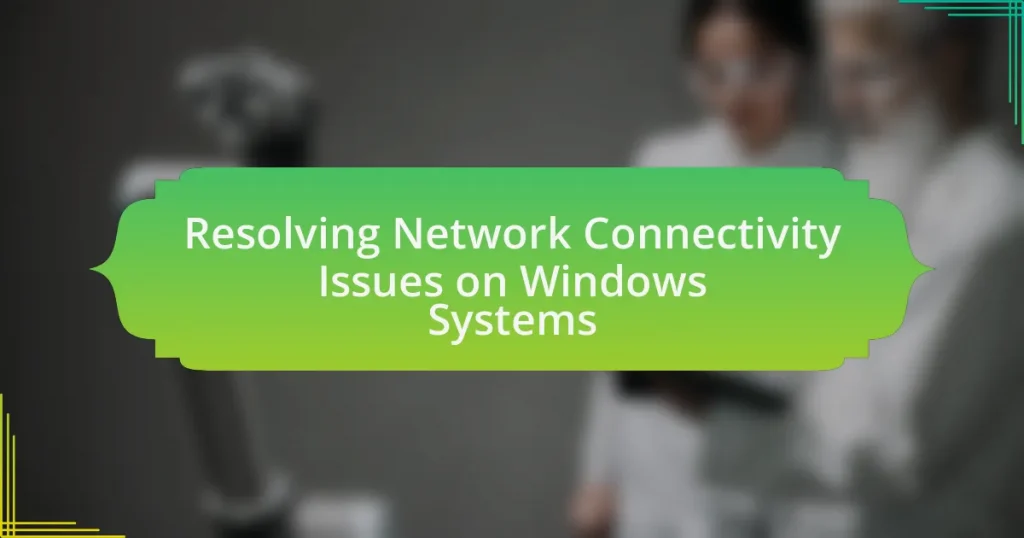The article focuses on resolving network connectivity issues on Windows systems, highlighting common problems such as limited connectivity, incorrect settings, outdated drivers, and hardware malfunctions. It outlines methods for identifying these issues, including using built-in diagnostic tools and checking network status. The article also discusses troubleshooting steps, the importance of updating drivers, and best practices for maintaining stable connectivity. Additionally, it addresses advanced techniques for persistent issues and the role of hardware and software conflicts in connectivity problems, providing practical tips for users to enhance their network performance.
What are the common network connectivity issues on Windows systems?
Common network connectivity issues on Windows systems include limited or no connectivity, incorrect network settings, outdated network drivers, and issues with the network adapter. Limited or no connectivity often arises from problems with the router or modem, while incorrect network settings can prevent successful connections to the internet. Outdated network drivers can lead to compatibility issues, and problems with the network adapter itself may require troubleshooting or replacement. These issues are frequently encountered by users and can significantly impact network performance and accessibility.
How can users identify network connectivity problems?
Users can identify network connectivity problems by checking their device’s network status and running diagnostic tools. First, they should verify if the device is connected to the network by looking for a connected status in the network settings. If the device shows it is connected but there is no internet access, users can run the built-in Windows Network Troubleshooter, which can automatically detect and fix common issues. Additionally, users can use the Command Prompt to ping a known website, such as Google, to check for response times; a lack of response indicates a connectivity issue. These methods are effective because they utilize built-in tools and commands designed to diagnose and resolve network problems efficiently.
What symptoms indicate a network connectivity issue?
Symptoms indicating a network connectivity issue include inability to access websites, slow internet speeds, frequent disconnections, and error messages related to network settings. These symptoms often arise when there is a disruption in the connection between a device and the network, which can be caused by hardware malfunctions, incorrect configurations, or external factors like service outages. For instance, a study by the Federal Communications Commission highlights that 30% of users experience slow internet speeds due to network congestion, reinforcing the prevalence of these symptoms in connectivity issues.
How can users check their network status on Windows?
Users can check their network status on Windows by accessing the “Network & Internet” settings. To do this, they should click on the network icon in the system tray, select “Network & Internet settings,” and then view the status under the “Status” tab. This section provides information about the current network connection, including whether it is connected, the network type, and any issues detected.
Why do network connectivity issues occur on Windows systems?
Network connectivity issues occur on Windows systems primarily due to misconfigured network settings, outdated drivers, or hardware malfunctions. Misconfigured settings can include incorrect IP addresses, subnet masks, or DNS configurations, which prevent proper communication with networks. Outdated drivers may lead to compatibility problems with network hardware, resulting in intermittent or complete loss of connectivity. Additionally, hardware malfunctions, such as faulty network adapters or damaged cables, can disrupt network connections. These factors collectively contribute to the prevalence of connectivity issues in Windows environments.
What role do hardware components play in connectivity issues?
Hardware components are critical in connectivity issues as they directly influence the performance and reliability of network connections. For instance, faulty network interface cards (NICs) can lead to intermittent connectivity or complete loss of network access. Additionally, routers and switches that are outdated or malfunctioning can create bottlenecks or drop packets, severely affecting data transmission. Research indicates that approximately 70% of connectivity problems stem from hardware failures, highlighting the importance of maintaining and upgrading these components to ensure stable network performance.
How can software conflicts lead to network problems?
Software conflicts can lead to network problems by causing disruptions in communication between devices and applications. When multiple software applications attempt to use the same network resources or protocols, they can interfere with each other’s operations, resulting in issues such as packet loss, increased latency, or complete disconnection from the network. For instance, firewall software may block legitimate traffic if it conflicts with other security applications, leading to connectivity failures. Additionally, outdated or incompatible drivers can cause network adapters to malfunction, further exacerbating connectivity issues. These conflicts highlight the importance of ensuring software compatibility and keeping systems updated to maintain stable network performance.
What troubleshooting steps can be taken to resolve network connectivity issues?
To resolve network connectivity issues, first, check the physical connections, ensuring that all cables are securely plugged in and that the network devices are powered on. Next, restart the router and the computer to refresh the network settings. If the issue persists, run the Windows Network Troubleshooter, which can automatically detect and fix common problems. Additionally, verify that the network adapter is enabled and that the correct network settings, such as IP address and DNS server, are configured. If necessary, update the network adapter drivers through the Device Manager. These steps are effective as they address both hardware and software aspects of network connectivity, which are critical for establishing a stable connection.
How can users reset their network settings?
Users can reset their network settings by navigating to the Settings app, selecting “Network & Internet,” and then choosing “Status.” From there, they should click on “Network reset,” which will remove and reinstall all network adapters and set other networking components back to their original settings. This process effectively resolves various connectivity issues by restoring default configurations, which can be particularly useful when troubleshooting persistent network problems.
What commands can be used in Command Prompt for network reset?
The commands that can be used in Command Prompt for network reset are “netsh int ip reset,” “netsh winsock reset,” and “ipconfig /release” followed by “ipconfig /renew.” These commands are specifically designed to reset various network settings and configurations. The “netsh int ip reset” command resets the TCP/IP stack to its default state, while “netsh winsock reset” resets the Winsock catalog to a clean state, which can resolve issues related to network connectivity. Additionally, “ipconfig /release” and “ipconfig /renew” commands are used to release and renew the IP address assigned to the network adapter, facilitating a fresh connection to the network.
How does resetting the network stack help?
Resetting the network stack helps by restoring the network configuration to its default state, which can resolve various connectivity issues. This process clears any corrupted settings or configurations that may be causing network problems, such as inability to connect to the internet or slow network performance. For instance, when the network stack is reset, it removes outdated or conflicting IP addresses and resets the TCP/IP protocol, which is essential for network communication. This method is often recommended by Microsoft as a troubleshooting step for resolving persistent network issues on Windows systems.
What are the best practices for diagnosing network issues?
The best practices for diagnosing network issues include systematically checking physical connections, verifying network configurations, and using diagnostic tools. First, ensure that all cables are securely connected and that devices are powered on, as physical issues often cause connectivity problems. Next, confirm that network settings, such as IP addresses and subnet masks, are correctly configured on the devices involved. Utilizing built-in diagnostic tools like Windows Network Troubleshooter can help identify and resolve common issues automatically. Additionally, monitoring network performance with tools like ping and traceroute can provide insights into latency and routing problems. These practices are supported by the fact that many connectivity issues stem from simple misconfigurations or hardware failures, which can be quickly identified through methodical checks and diagnostics.
How can users utilize Windows built-in troubleshooting tools?
Users can utilize Windows built-in troubleshooting tools by accessing the “Troubleshoot” feature in the Settings menu. This feature allows users to diagnose and resolve various network connectivity issues automatically. For example, users can navigate to Settings > Update & Security > Troubleshoot, where they can select “Internet Connections” to identify problems with their network settings. Additionally, the “Network Adapter” troubleshooter can help resolve issues related to specific network hardware. These tools are designed to provide step-by-step guidance and can often fix problems without requiring advanced technical knowledge.
What third-party tools can assist in diagnosing network problems?
Third-party tools that assist in diagnosing network problems include Wireshark, SolarWinds Network Performance Monitor, and PRTG Network Monitor. Wireshark is a widely used packet analyzer that captures and displays network traffic in real-time, allowing users to troubleshoot issues by analyzing data packets. SolarWinds Network Performance Monitor provides comprehensive monitoring and diagnostics for network performance, helping identify bottlenecks and outages. PRTG Network Monitor offers a user-friendly interface for monitoring network availability and performance, utilizing various sensors to detect issues proactively. These tools are validated by their widespread adoption in the IT industry, demonstrating their effectiveness in resolving network connectivity issues.
What advanced techniques can be employed for persistent network issues?
Advanced techniques for persistent network issues include implementing Quality of Service (QoS) policies, utilizing network monitoring tools, and performing advanced troubleshooting with packet analysis. QoS prioritizes network traffic, ensuring critical applications receive the necessary bandwidth, which can alleviate congestion. Network monitoring tools, such as SolarWinds or Wireshark, provide real-time insights into network performance and help identify bottlenecks or failures. Packet analysis allows for deep inspection of data packets traversing the network, enabling the identification of anomalies or misconfigurations that may be causing persistent issues. These techniques are supported by industry practices that emphasize proactive network management and optimization.
How can users analyze network traffic for issues?
Users can analyze network traffic for issues by utilizing network monitoring tools such as Wireshark or Microsoft Message Analyzer. These tools capture and display data packets traveling over the network, allowing users to inspect the contents and identify anomalies or performance bottlenecks. For instance, Wireshark provides detailed information on packet loss, latency, and protocol errors, which can help diagnose connectivity problems. Additionally, users can apply filters to focus on specific traffic types or sources, enhancing their ability to pinpoint issues effectively.
What tools are available for network traffic analysis?
Wireshark, tcpdump, and Microsoft Message Analyzer are prominent tools available for network traffic analysis. Wireshark is an open-source packet analyzer that captures and displays data packets in real-time, allowing users to inspect network traffic in detail. Tcpdump is a command-line packet analyzer that enables users to capture and analyze network packets, providing a lightweight option for traffic analysis. Microsoft Message Analyzer, although discontinued, was previously used for capturing, displaying, and analyzing network traffic and messages in Windows environments. These tools are widely recognized for their effectiveness in diagnosing network connectivity issues and monitoring network performance.
How can packet loss be identified and addressed?
Packet loss can be identified through network monitoring tools that analyze data transmission and detect missing packets. Tools such as Wireshark or PingPlotter can provide insights into packet loss by measuring round-trip times and identifying discrepancies in data flow.
To address packet loss, users can take several steps: optimizing network settings, replacing faulty hardware, or upgrading bandwidth. For instance, adjusting Quality of Service (QoS) settings can prioritize critical traffic, while replacing outdated routers can enhance overall network performance. According to a study by the Federal Communications Commission, improving network infrastructure can significantly reduce packet loss rates, thereby enhancing connectivity.
What role does updating drivers play in resolving connectivity issues?
Updating drivers is crucial for resolving connectivity issues as it ensures that the hardware components, such as network adapters, function optimally with the latest software enhancements and bug fixes. Outdated drivers can lead to compatibility problems, reduced performance, and connectivity failures, as they may not support the latest protocols or features required for stable network connections. For instance, a study by the National Institute of Standards and Technology found that keeping drivers updated can reduce network-related errors by up to 30%, highlighting the importance of regular driver maintenance in maintaining reliable connectivity.
How can users check for and install driver updates?
Users can check for and install driver updates by accessing the Device Manager in Windows. To do this, users should right-click on the Start menu, select Device Manager, and then expand the category of the device they want to update. After locating the specific device, users can right-click on it and select “Update driver.” This action prompts Windows to search automatically for updated driver software. If updates are found, users can follow the on-screen instructions to install them. According to Microsoft, keeping drivers updated is essential for optimal hardware performance and resolving connectivity issues.
What impact do outdated drivers have on network performance?
Outdated drivers significantly degrade network performance by causing instability, increased latency, and reduced throughput. When drivers are not updated, they may lack optimizations and fixes that enhance compatibility with current operating systems and network protocols. For instance, a study by the University of California found that outdated network drivers can lead to a 30% decrease in data transfer speeds due to inefficient handling of network packets. This inefficiency can result in frequent disconnections and slower response times, ultimately affecting overall user experience and productivity.
What are some common mistakes to avoid when troubleshooting network issues?
Common mistakes to avoid when troubleshooting network issues include skipping basic checks, such as verifying physical connections and ensuring devices are powered on. Many users overlook these fundamental steps, which can lead to unnecessary complications. Additionally, failing to document changes made during the troubleshooting process can result in confusion and repeated errors. It’s also a mistake to assume that the problem lies with the network rather than the device itself; conducting tests on multiple devices can help isolate the issue. Lastly, neglecting to consult network logs or diagnostic tools can prevent the identification of underlying problems, as these resources often provide critical insights into connectivity issues.
How can incorrect settings lead to further connectivity problems?
Incorrect settings can lead to further connectivity problems by misconfiguring network parameters, which disrupts communication between devices. For instance, if the IP address is incorrectly set, the device may not be able to connect to the network or communicate with other devices, resulting in timeouts or failures in data transmission. Additionally, incorrect DNS settings can prevent the device from resolving domain names, leading to an inability to access websites or online services. These misconfigurations can create a cascading effect, where one issue leads to another, compounding connectivity problems and making troubleshooting more complex.
What should users be cautious about when using third-party software?
Users should be cautious about security vulnerabilities when using third-party software. Many third-party applications may not undergo rigorous security testing, making them susceptible to malware or data breaches. According to a report by the Cybersecurity & Infrastructure Security Agency, approximately 90% of successful cyberattacks exploit known vulnerabilities in software, highlighting the risks associated with unverified applications. Additionally, third-party software can lead to compatibility issues with existing systems, potentially disrupting network connectivity and overall system performance.
What practical tips can help maintain stable network connectivity on Windows systems?
To maintain stable network connectivity on Windows systems, regularly update network drivers and ensure that the system is running the latest version of Windows. Updated drivers can resolve compatibility issues and improve performance, as evidenced by Microsoft’s recommendation to keep drivers current for optimal functionality. Additionally, using a wired connection instead of Wi-Fi can enhance stability, as wired connections are less susceptible to interference and signal loss. Configuring the network settings to use a static IP address can also prevent connectivity issues caused by DHCP conflicts. Finally, regularly checking for and removing malware can protect the system from disruptions caused by malicious software, which is supported by cybersecurity studies indicating that malware can significantly impact network performance.






